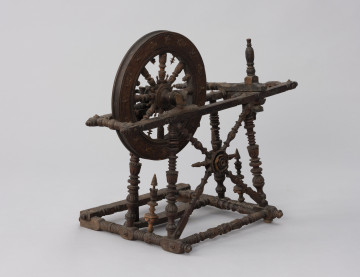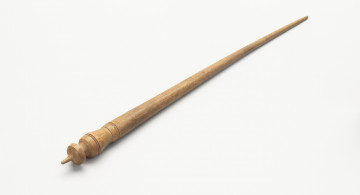
Horizontal spinning wheel
1801 — 1900
National Museum in Szczecin
Part of the collection: Folk weaving
The distaff is a tool used for spinning flax and hemp fibres or, less frequently, woollen fibres. In its simplest form, it took the form of a stick of a few tens of centimetres held in the hand, under the arm or clipped behind the belt of an apron. A coil of filaments beside each other, or sliver, was attached to it and used in conjunction with a spindle. To hold the sliver in place, a string was tied at the top of the tool and loosely wrapped around it. The spinner would pull the fibres from the sliver with her left hand, moisten them with saliva and twist them in her fingers. She would then hook them onto a spindle, which she would release with her right hand into a rapid, spinning motion. Spinning fibres has always been seen as a feminine occupation, and the distaff itself as one of the attributes of femininity. In Polish, there is even the phraseological compound 'po kądzieli' referring to relatives on the mother's side. In Pomerania, as in other regions, it was customary for the groom to offer a distaff to his bride. Made for gift giving, the distaff was richly decorated and often signed with the girl's initials. It was not a utilitarian object, but had symbolic and decorative value. The presented distaff is a non-professional product, made for one's own use and quite unusual, as it cannot be clearly assigned to any of the basic types of distaffs. Agnieszka Słowińska
Author / creator
Object type
distaff
Technique
hewn, planing
Material
wood
Origin / acquisition method
acquisition
Creation time / dating
Creation / finding place
Owner
Muzeum Narodowe w Szczecinie
Identification number
Location / status

1801 — 1900
National Museum in Szczecin

1945 — 1970
National Museum in Szczecin

1880 — 1920
National Museum in Szczecin
DISCOVER this TOPIC
Museum of King Jan III's Palace at Wilanów
DISCOVER this PATH
Educational path